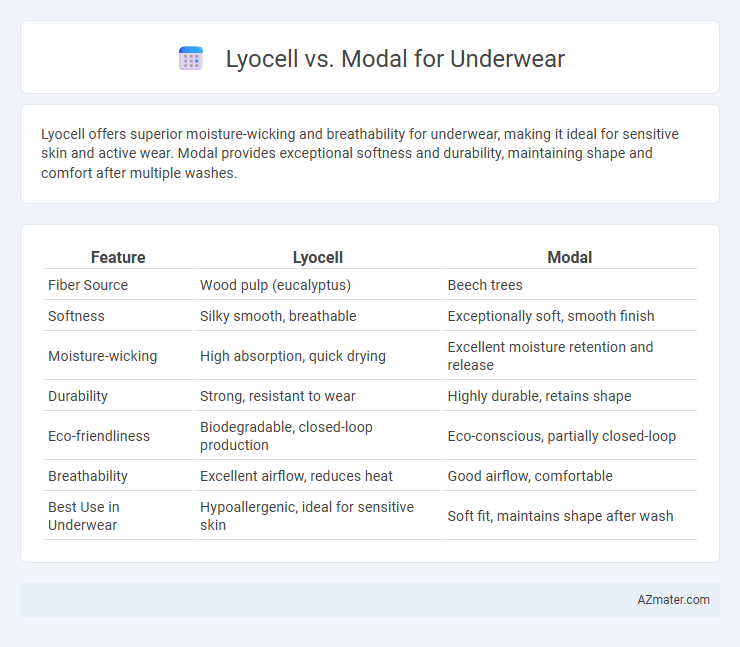Lyocell offers superior moisture-wicking and breathability for underwear, making it ideal for sensitive skin and active wear. Modal provides exceptional softness and durability, maintaining shape and comfort after multiple washes.
Table of Comparison
| Feature | Lyocell | Modal |
|---|---|---|
| Fiber Source | Wood pulp (eucalyptus) | Beech trees |
| Softness | Silky smooth, breathable | Exceptionally soft, smooth finish |
| Moisture-wicking | High absorption, quick drying | Excellent moisture retention and release |
| Durability | Strong, resistant to wear | Highly durable, retains shape |
| Eco-friendliness | Biodegradable, closed-loop production | Eco-conscious, partially closed-loop |
| Breathability | Excellent airflow, reduces heat | Good airflow, comfortable |
| Best Use in Underwear | Hypoallergenic, ideal for sensitive skin | Soft fit, maintains shape after wash |
Introduction: Lyocell vs Modal for Underwear
Lyocell and Modal are both popular fabrics used in underwear due to their softness and breathability. Lyocell, made from sustainably sourced wood pulp through a closed-loop process, offers superior moisture-wicking properties and durability. Modal, derived from beech tree cellulose, provides exceptional softness and elasticity, making it comfortable for everyday wear.
What is Lyocell?
Lyocell is a sustainable fabric made from wood pulp, primarily eucalyptus trees, known for its eco-friendly closed-loop production process that recycles water and solvents. It offers exceptional breathability, moisture-wicking properties, and a soft, smooth texture ideal for comfortable underwear. Compared to Modal, Lyocell tends to be more durable and environmentally responsible, making it a preferred choice for eco-conscious consumers seeking high-performance, natural underwear fibers.
What is Modal?
Modal is a type of semi-synthetic fiber made from beech tree pulp, known for its exceptional softness, moisture-wicking properties, and durability. It is often compared to Lyocell due to its breathable and smooth texture, making it ideal for underwear that offers comfort and breathability. Modal fabric resists shrinking and pilling, ensuring that underwear maintains its shape and softness after multiple washes.
Sustainability Comparison
Lyocell and Modal are both sustainable fabrics derived from wood pulp, but Lyocell boasts a more environmentally friendly production process using non-toxic solvents in a closed-loop system that recycles 99% of chemicals and water. Modal, while biodegradable and biodegradable, typically involves a more energy-intensive process and uses more water, impacting its overall sustainability footprint. Prioritizing Lyocell for underwear offers reduced environmental impact through lower water consumption and higher recyclability of solvents, making it a preferred choice for eco-conscious consumers.
Comfort and Softness
Lyocell and Modal are both semi-synthetic fibers known for their exceptional softness and breathability, making them ideal for underwear. Lyocell, derived from eucalyptus wood pulp, offers superior moisture-wicking properties and a smooth, silky texture that enhances comfort throughout the day. Modal, sourced from beech tree pulp, is prized for its luxurious softness and excellent durability, retaining its softness even after multiple washes.
Breathability and Moisture-Wicking
Lyocell fabric offers superior breathability and moisture-wicking properties compared to modal, making it ideal for underwear designed to keep the skin dry and comfortable. Derived from sustainably sourced wood pulp, Lyocell fibers allow enhanced airflow and efficiently draw moisture away from the body, reducing sweat buildup and odor. Modal, while also breathable and moisture-absorbent, tends to retain more moisture, which can lead to less effective drying and potential discomfort during extended wear.
Durability and Longevity
Lyocell offers superior durability and longevity compared to Modal due to its stronger fiber structure and resistance to pilling and shrinkage. Modal tends to wear out faster with repeated washes, losing softness and shape over time, whereas Lyocell maintains its integrity and comfort for longer periods. For underwear, this makes Lyocell the preferred choice for sustained wear and lasting quality.
Skin Sensitivity and Hypoallergenic Properties
Lyocell offers superior skin sensitivity benefits due to its smooth fibers that reduce irritation and promote breathability, making it ideal for people with sensitive skin. Modal is also hypoallergenic and moisture-wicking but can be slightly less gentle compared to Lyocell because of its manufacturing process involving chemical treatments. Both fabrics provide excellent softness and durability, yet Lyocell's natural, eco-friendly production enhances its hypoallergenic properties for underwear.
Care and Maintenance
Lyocell underwear offers exceptional durability and resists pilling due to its smooth fiber structure, making it easier to maintain with gentle machine washing in cold water and air drying. Modal fabric, while softer and more breathable, requires careful handling to prevent shrinkage and fabric weakening, best maintained by washing in cold water on a delicate cycle and line drying. Both fabrics benefit from avoiding bleach and high heat, preserving their softness and extending the lifespan of underwear garments.
Which is Better for Underwear: Lyocell or Modal?
Lyocell and Modal are both popular for underwear due to their softness and breathability, but Lyocell is generally better for moisture management and durability, making it ideal for sensitive skin and active use. Modal offers exceptional smoothness and a silky feel, often preferred for luxury and comfort in everyday wear but tends to be less durable than Lyocell. Choosing between Lyocell and Modal depends on prioritizing moisture-wicking performance and longevity (Lyocell) versus silky texture and comfort (Modal).

Infographic: Lyocell vs Modal for Underwear
 azmater.com
azmater.com